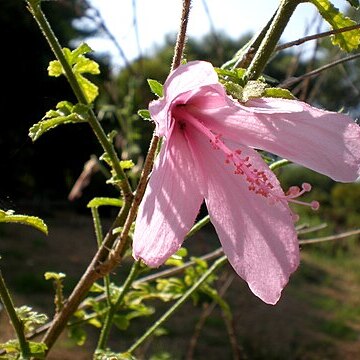Shrublet, 0.3-2.4 m high; stems pilose. Leaves ovate in outline, 3-lobed with broad sinuses, base obtuse, apex rounded, margins toothed, 5-7-nerved, indumentum of stiff-ish, simple or branched hairs. Flowers axillary, solitary; peduncles up to 120 mm long, articulated ± 10 mm below apex. Epicalyx of 7 or 8 linear-elliptic bracts. Calyx with lobes lanceolate. Petals obovate, pale lilac or pink. Staminal tube 20-30 mm long; filaments ± 1 mm long. Flowering time Aug.-May. Fruit a subglobose capsule, acuminate at apex, hispid. Seeds with white or brownish fuzz.
Leaf-lamina 2–8·5 × 2–8 cm., suborbicular to ovate in outline, 3-lobed, with stiffish simple or branched hairs on both surfaces, apex rounded, margin bluntly toothed, base obtuse to slightly cordate 5–7-nerved; lobes rounded at the apex; petiole 0·6–4·5 cm. long; stipules 4 mm. long, subulate.
Slender, shortly hairy shrublet to 1.2 m. Leaves mostly 3-5-lobed, toothed. Flowers axillary, on long peduncles, mostly pink, epicalyx of 10-12 linear-oblanceolate lobes, staminal tube 20-30 mm long; seeds with silky floss.
Flowers up to 7 cm. in diam., pale lilac or pink, solitary, axillary; peduncles 4–12 cm. long, appressed-stellate-setulose, articulated 3–10 mm. below the apex.
Perennial herb, 1-2 m high. Peduncles 40-120 mm long. Petals 30-45 mm long. Staminal tube 20-30 mm long. Flowers pale lilac or pink.
Epicalyx of 7–8 bracts, usually slightly exceeding the calyx; bracts 14–18 × 1–3·5 mm., linear to linear-elliptic.
Staminal tube 20–30 mm. long; anthers borne on the upper half of the tube; free parts of filaments 0·5–1 mm. long.
Calyx up to 16 mm. long, setulose-hispid; lobes 10–16 × 3–5 mm., lanceolate.
Petals 3–4·5 cm. long, obovate, stellate-pubescent outside, glabrous within.
Capsule 10–12 × 8–10 mm., subglobose, hispid, acuminate at the apex.
Perennial herb 1–2 m. tall; stems densely appressed-stellate-pilose.
Seeds with a white or brownish fuzz.
Style-branches 2–5 mm. long.

